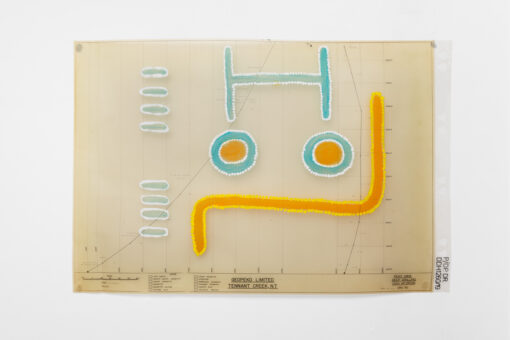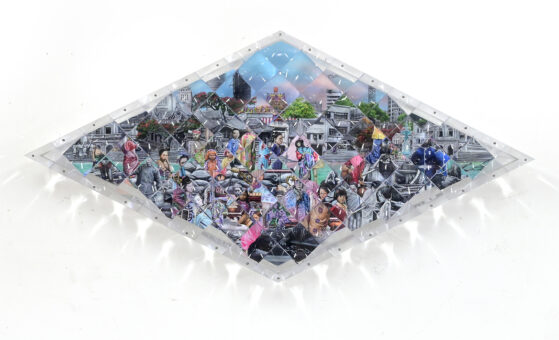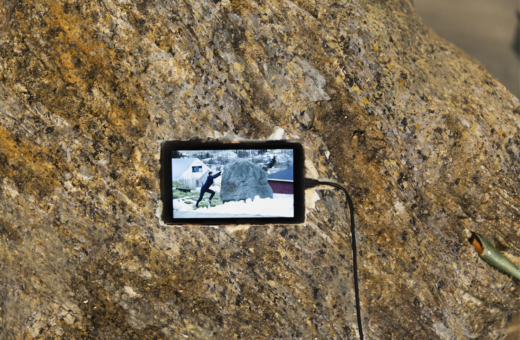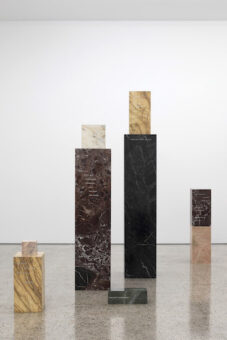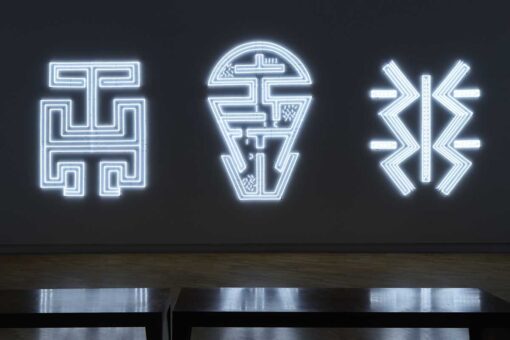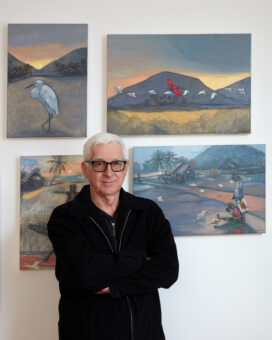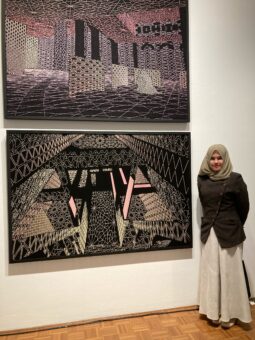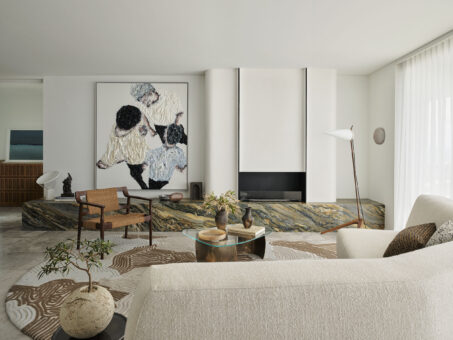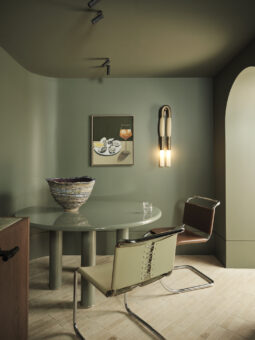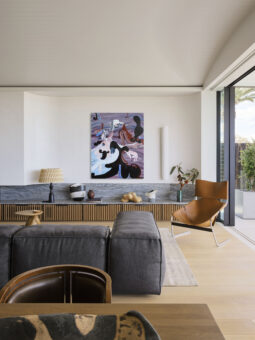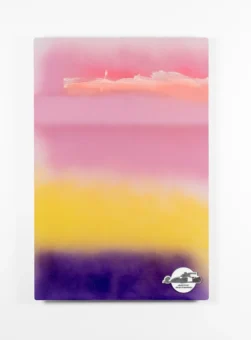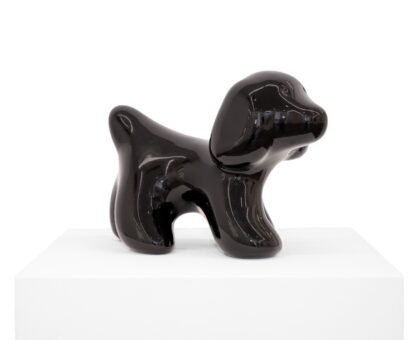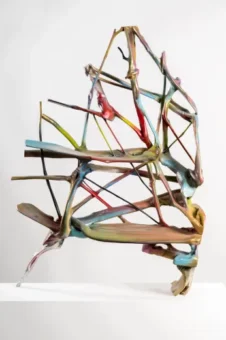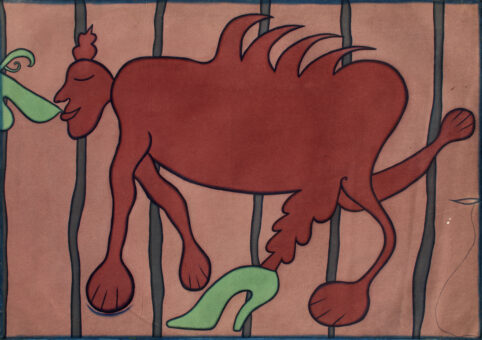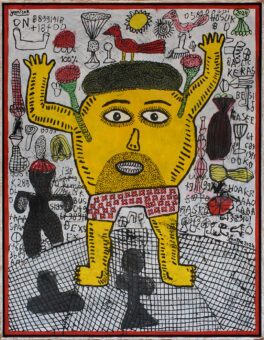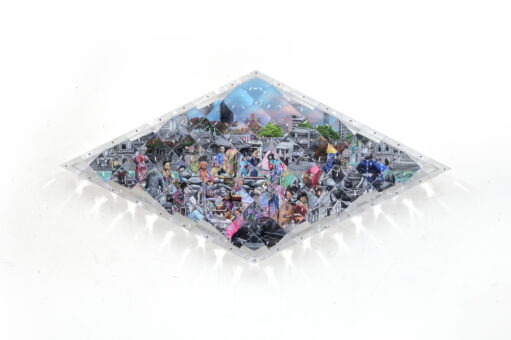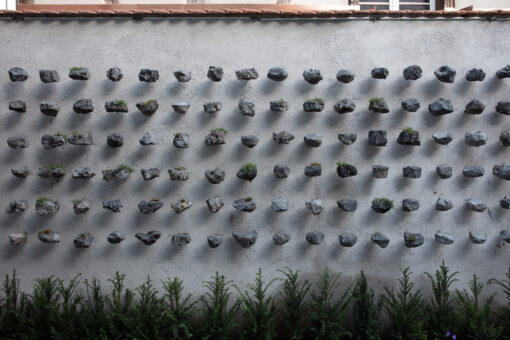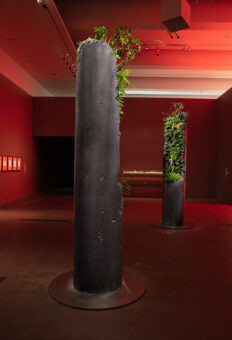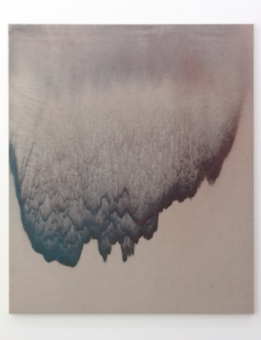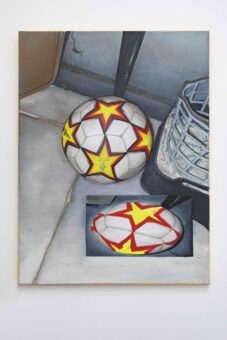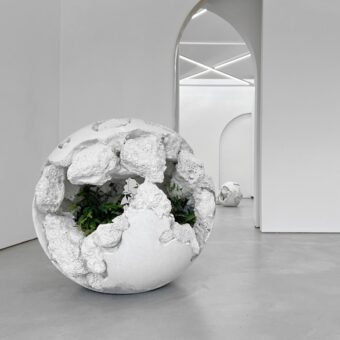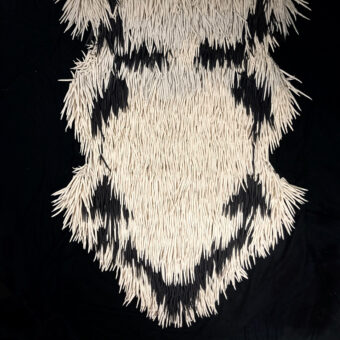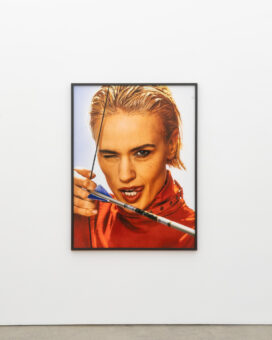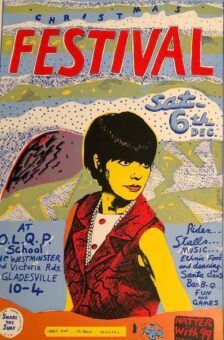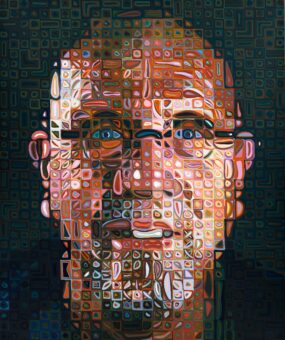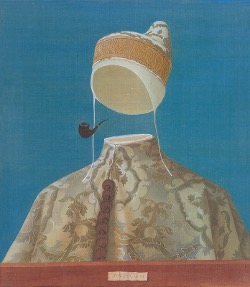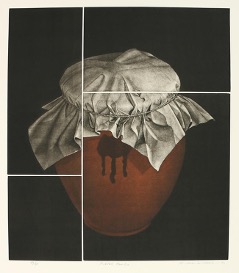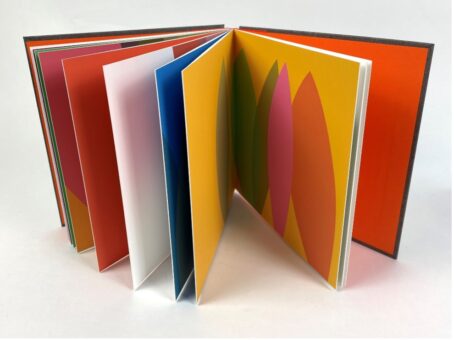Sam Watson-Wood, Performance Contemporary program curator and Director of Friends with Strangers, shares the artworks she’s most looking forward to seeing at Sydney Contemporary 2024.
1 – Tennant Creek Brio – Eleanor Jawurlngali Dixon & Rupert Berthas, Black Cross, 2024, Cassandra Bird
“The collective’s work addresses the ongoing tensions between Indigenous and settler cultures, revitalises traditional practices, and celebrates community resilience, all while drawing from deeply personal, multigenerational experiences. I find the graphic nature of their work engaging, urgent, playful and genius.”
2 – Adele Warner, What you see in others (exists in you), 2024, Minerva
“Warner’s work holds alienation, nostalgia, and intimacy, presenting an uncomfortable synthesis of a hybrid online/offline world. It explores both disconnection and connection. It is personal and visceral.”
3 – Suzann Victor, Prismatic River 2022, Gajah Gallery
“Victor’s ‘Lens-Painting Series’ reimagines early colonial postcards of Southeast Asia. The works are intricate hand-painted compositions placed beneath lenses. It is like peering into a river, the view obscured; providing a kaleidoscope of scenes that breaks up the invasive gaze.”
4 – Shan Turner Carroll, Bodies on a Rock, 2022, COMA
“Turner-Carroll, explores the hidden realms of knowledge and exchange, queering and questioning the intricate relationships between humans, nature, and art itself. I have read his work can sing to snakes, serenade and signal with aliens, and barter with islands, rivers, and oceans and I believe it.”
5 – Stanislava Pinchuk, The Wine Dark Sea, 2021, Ames Yavuz
“This work is from a series called “the Wine Dark Sea” Pinchuk intertwines language from Australian offshore detention center reports with Homer’s Odyssey, using marble sculptures to highlight shared themes of exile and displacement. I love how she creates these elegant monoliths to stand as monuments of truth.”
6 – Darrell Sibosado, Galalan at Gumiri, 2023-24, N.Smith Gallery
Sibosado is a Bard man from Lombadina situated on the Dampier Peninsula of the Kimberley coast. He makes Riji, or ancient pearl shell designs into modern light sculptures and installations that echo the glistening scales of the Rainbow Serpent on the Ocean. A few years ago I stayed in Lombadina and when I see these works I remember that place and imagine a serpent on the intense turquoise water.
Conversation with John Cruthers, Director of 16albermarle Project Space.
Tell us about how 16albermarle Project Space came into existence?
In 2013 I attended the first Sydney Contemporary and was blown away by the work I saw at the nine galleries from southeast Asia, and the gallerists and artists I met. I went home and said to my wife that the southeast Asian art was more interesting than Australian art. We started travelling in the region learning about the art and after 5 years we knew enough to start 16albermarle Project Space.
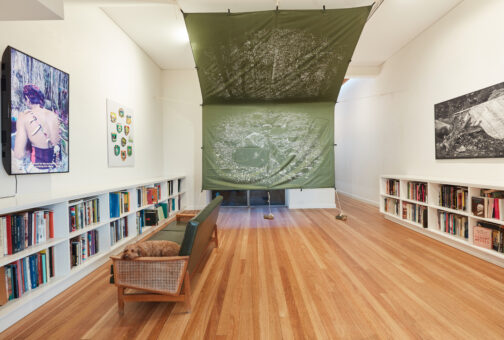
Installation View – Tanah/Land exhibitions, Surajate Tongchua and Maryanto
Could you share one of the most memorable times you’ve had working as a gallerist?
I always really enjoyed helping people find ways into art, whether it’s from Indonesia, Thailand, Cambodia, Myanmar, Singapore etc. Mostly the art is lively and people are engaged, but when there’s a little bit of context and information really helps. Once clients start learning, many of them come on our annual art study tours to meet the artists and learn more. We go to Indonesia in June each year, and Thailand in December.
Tell us about the artist/s you’re showcasing at this year’s Fair?
We have six younger and mid-career artists from Jogjakarta and Bali – painter Arwin Hidayat, batik artist Dias Prabu, painter Popok Tri Wahyudi and his partner performance artist and painter Agnes Christina, graphic (drawing) artist Radetyo Itok and printmaker Kadek Dwi Darmawan.
What’s happening next in the world of 16albermarle Project Space?
After five years of being mainly an exhibition space, we are rebalancing to put more emphasis on other activities – art study tours (Cambodia is being added in 2025), art fairs, exhibition development and touring, residencies and representing southeast Asian artists within sectors including interior design, architecture, fashion and public art. We want to be a one-stop shop for people wanting to connect with southeast Asian art.
Mariem Chant, Other Possible Worlds.
Learn more about 16albermarle Project Space here.
Conversation with Alexandra Donohoe Church, Managing Director and Founder of Decus.
Can you share insights into your journey, background, and the path that brought you to founding Decus and where you are today?
My journey into interior design began serendipitously during my first year at UNSW. Initially studying Landscape Architecture, I realised my creative path lay within the built environment and switched my focus to Interior Architecture. Growing up multi-culturally, having lived in the US during my childhood before returning to Australia, greatly influenced my view of the world. My childhood in the US and global sourcing trips have inspired me deeply. I’m particularly drawn to the ethos of Mid-Century Brazilian designers, blending a humanistic approach to form, balance, and texture in my work. My designs are characterised by refined curation, whimsical detailing, and provocative combinations of finish. The Global Financial Crisis (GFC) certainly contributed to being retrenched from my practice at the time and was the push I needed to go out on my own. This period gifted me grit, tenacity, and an understanding of what it takes to create something you’re proud of from scratch.
Why do you feel the intersection of art, architecture and design hold such significance?
Because nothing is in a silo, each is altered by the other. It’s connective. A piece of art isn’t just a standalone object it is a unique perspective based on experience and/or perception, it engages in a conversation with its surroundings, other artworks, and the environment in which it resides. The intersection of art, architecture, and design is significant because it creates a visual rhythm within a space between different forms of creative expression. When these elements are thoughtfully integrated, they elevate each other, transforming spaces into immersive environments that evoke emotion, inspire thought, debate and questions that enrich our lives. The interplay of these disciplines reflects the human experience, blending aesthetic beauty with functionality and shaping how we perceive and interact with the world around us and the spaces we live in.
How does contemporary art align with the design ethos of Decus?
We see art as a crucial element that bridges the gap between the design concept and the personal narratives of the spaces we create. My journey with art began in tandem with my journey into design. Art is a vital component that brings depth and meaning to a space. We view art as a dynamic force that interacts with its surroundings. This dialogue creates environments that are deeply reflective of the individuals who inhabit them. Contemporary art, with its evolving nature and ability to evoke emotion, perfectly complements our approach to design, where every element is thoughtfully curated to resonate with the people and the purpose of the space.
Can you tell us about the inspiration behind the design concept for The Mezzanine Lounge at Sydney Contemporary this year?
The inspiration behind the design concept for The Mezzanine Lounge at Sydney Contemporary this year was to create a compact and immersive antidote to the frantic energy of the fair. We envisioned a singular space that envelops visitors like a womb, offering refuge from below. We wanted the entry to evoke the sophistication of an iconic nightclub, with every surface thoughtfully covered in rich textures. The design transitions seamlessly from day to night, ensuring an unparalleled sanctuary for relaxation and exclusivity.
How does Decus approach balancing functionality and aesthetic appeal in its designs, particularly in a space like The Mezzanine?
We design for our clients, who have complex, unique needs. It’s why all of our projects look so different. We spend a lot of time with our clients fully understanding their brief and how they live in a space, this process ensures that the functionality of the spaces suits every aspect of a client’s home life.
In a similar fashion we really wanted to understand the purpose of the Mezzanine space rather than starting just with a creative concept. As a result, we’ve managed to create a versatile space, allowing for the array of events and clients that the fair be hosting within it.
What trends or innovations in interior design do you see emerging in spaces designed for hospitality and cultural events like Sydney Contemporary?
Immersive spaces that transport people in a visceral or physically sensory way, as opposed to an environment that is ticking a series of practical and functional boxes.
Learn more about award-winning interior design studio Decus.
We spoke with Gallery co-director, Riley Davison from NAP Contemporary to talk about their presentation for Sydney Contemporary 2024.
How do you characterize the philosophy of NAP Contemporary as a gallery?
There’s such a scarcity of private galleries in regional Australia who try and engage with contemporary art in a meaningful way. Our ambition was to bring new voices in pacific art to our growing regional city. Our philosophy is to create a space for artists to extend their practices to a new level, and to give them exposure to a collector base here and overseas. We sometimes invite recent art school graduates to exhibit with us, we also showcase mid and late career artists from across the country and abroad.
Scott Redford, Auto Rothko (Pink), 2024. Courtesy of the artist and NAP Contemporary.
You have been working in galleries for 3 years. What’s special about the gallery world for you?
When Erica Tarquinio and I opened NAP just 3 years ago we had no gallery experience, everything we know has been learned in that time, often through making mistakes and looking to other new galleries, also ARI’s, for inspiration. Prior to opening the gallery, we both worked for many years for indigenous art centres, and so our experience is largely from the other side of the sector, the benefit of that being we understand artist advocacy. Entering the gallery world has been a learning curve for us, and since then we have enjoyed working with many great artists, collectors and curators in a short time. Working alongside creative people on a full-time basis is such a privilege and we have been proud to contribute to the gallery scene and felt a warm reception to our emergence.
Scott Redford, Puppy, 2024. Courtesy of the artist and NAP Contemporary.
What are you most excited about for your first time exhibiting at Sydney Contemporary?
We first visited the fair in 2022, we were astounded by the scale and vibrancy of it and honestly at that time I don’t think we even imagined being able to participate! It was working with Scott Redford over the past year or so that we realised it would be the perfect platform for an artist of his significance and vision. It will be our first solo presentation at a fair, and it’s a thrill to really bring something of national significance – and with a generous dose of fun. At many will know, Scott has been exhibiting since 1983 with major exhibitions at NGV, ACMI, AGSA, AGNSW, GOMA including international shows, amassing 8 dedicated publications. His new work is really a knockout, and we are thrilled to showing at Sydney Contemporary.
Scott Redford, Made by Unknown Artist. Bought on Facebook marketplace and painted by Dipit Kustoms, Geebung, Brisbane, 2024. Courtesy of the artist and NAP Contemporary.
What advice would you give someone looking to start their own collection at the fair this year?
Heading into a fair like Sydney Contemporary you can’t help being overwhelmed by the variety of offerings. Starting a collection is a very personal thing of course, I believe in shortlisting works which resonate with you, and then diving a little deeper, with your own research and/or the guidance of a gallerist. In retrospect your first piece is always going to be special, but an early acquisition of an important work is a great cornerstone to a collection. I think it’s the role of a gallerist to offer guidance in terms of the kinds of value a particular artist or artwork can add to a collection. A new collection is an exciting journey, a good one embodies the perspective of the owner and represents a certain moment in art history. Come have a chat with Erica and I at booth J01.
Learn more about NAP Contemporary
We spoke with Gallery Director , Jasdeep Sandhu from Gajah Gallery to talk about their presentation for Sydney Contemporary 2024.
How do you characterize the philosophy of Gajah Gallery as a gallery?
At Gajah Gallery, our philosophy is intertwined with the exploration of Southeast Asian art. We are committed to providing a platform where artists can challenge conventional boundaries, allowing their distinctive voices to resonate within the global art community. Our mission is not only to delve into the rich cultural narratives of the region but also to push the envelope in terms of materiality and artistic expression. An essential part of our philosophy is the documentation of history through art. We have had
the privilege of discovering and championing artists like I Gusti Ayu Kadek Murniasih and Semsar Siahaan, whose works serve not only as artistic expressions but also as vital cultural and historical records. Collaborating with esteemed curators and historians, such as T.K. Sabapathy, Michelle Antoinette, and Dr Wulan Dirgantoro we aim to ensure that the diverse histories of Southeast Asia are documented and integrated into the global art discourse.
Through collaborations with our art space and foundry, Yogya Art Lab (YAL) in Yogyakarta, Indonesia, we support our artists in experimenting with new mediums and techniques, ensuring their work reflects their heritage while engaging with contemporary issues in innovative and compelling ways. This approach allows us to continuously evolve, pushing the boundaries of what Southeast Asian art can achieve on the world stage.
I Gusti Ayu Kadek Murniasih (b.1966 – d.2006), Nikmat (Enjoyable), 2000. Courtesy of Gajah Gallery.
You have been working in galleries for over 25 years. What’s special about the gallery world for you?
Since founding Gajah Gallery in 1996, what stands out to me is the ongoing dialogue between tradition and innovation that defines the gallery world. At Gajah Gallery, we are constantly navigating this dynamic intersection, where the past informs the present, and where every exhibition introduces fresh perspectives while connecting to deeper cultural narratives. The gallery serves as a nexus where artists, curators, and collectors converge to explore ideas, challenge perceptions, and create meaning.
One of the most fulfilling aspects of this journey has been our commitment not only to discovering what’s next in the art world but also to looking back and unearthing important artists who may have been overlooked or forgotten. For instance, Semsar Siahaan, a seminal figure in Indonesia’s progressive movement, reflects our dedication to researching and bringing such artists to light. Siahaan’s fervent activism and incisive social commentary are integral to the history of Indonesia’s political landscape, yet his contributions have often been underappreciated.
Moreover, our efforts to bring attention to figures like Bagyi Aung Soe, the trailblazer of modern Burmese art, demonstrate our dedication to exploring the rich artistic traditions of Southeast Asia. Aung Soe’s melding of traditional Asian art forms with Western modernism and his pursuit of art as a vehicle for spiritual and social transformation have earned him both respect and reverence. Our collaboration with The Centre Pompidou, in Paris, France, for a major exhibition on Aung Soe in 2021, alongside a publication launched by Gajah Gallery, exemplifies our ongoing mission to ensure that these significant artists are accorded their rightful place in art history.
Our work with Indonesian artist Yunizar, with whom we co-founded YAL, represents our forward-looking approach. Through YAL, we’ve been able to support artists in expanding their practices into new mediums, such as sculpture. This collaboration has resulted in works that will be featured at the fair, underscoring our commitment to both preserving and advancing the artistic heritage of Southeast Asia. Witnessing the evolution of artists’ practices and playing a role in bringing their visions to the public has been a privilege. This continuous exchange of ideas, the sense of community, and the shared passion for art are what make this field truly unique and endlessly engaging.
Yunizar, Yellow Man, 2024. Courtesy of the artist and Gajah Gallery.
What are you most excited about for your first time exhibiting at Sydney Contemporary?
We are excited to debut at Sydney Contemporary, as it offers a prime opportunity to present the rich diversity and dynamism of Southeast Asian contemporary art to a broader audience. I am particularly excited to showcase the works of two female artists who have made Australia their home: Singapore-born Suzann Victor and Malaysian artist Kayleigh Goh.
Victor is renowned for her bold exploration of light, space, and movement, creating immersive experiences that challenge the viewer’s perception. Her work, which often interrogates themes of power, gender, and identity, resonates deeply within today’s socio-political context. Kayleigh Goh, on the other hand, employs minimalistic forms and textures to evoke a sense of calm and contemplation, reflecting her nuanced understanding of space and memory. Both artists bring a profound sensitivity and intellectual depth to their work, making their contributions particularly significant in this setting.
Additionally, this platform allows us to continue our efforts to highlight the late Balinese artist I Gusti Ayu Kadek Murniasih, whose bold and surreal paintings continue to provoke thought and resonate with viewers.
Our participation in Sydney Contemporary underscores our dedication to maintaining a strong presence in Australia, following our involvement in the 24th Biennale of Sydney, where we highlighted Murniasih’s work. This fair represents a pivotal moment for us to connect with Australian collectors and art enthusiasts, fostering new relationships and dialogues, and reinforcing the significance of female artists within the global art narrative.
Suzann Victor, Prismatic River, 2022. Courtesy of the artist and Gajah Gallery.
What advice would you give someone looking to start their own collection at the fair this year?
For those new to collecting, approach the fair with an open mind and curiosity. Trust your instincts, and don’t hesitate to ask a gallerist for more information about the art and artists. The art fair offers a unique opportunity to view a vast array of works in a short time, so take advantage of it. Engaging with the stories behind the artworks can enhance your experience, and remember, it’s perfectly fine to start small, especially with works by emerging artists, which often provide an affordable entry point.
Let love and passion guide your collection – buy what brings you joy, whether it’s the colours, movement, or memories a piece evokes. Practical considerations like measuring your wall space are important, but ultimately, your collection should be a reflection of your personal vibe and bring you joy. Whether it’s the colours, the movement, or the memories a piece evokes, buy art that speaks to you on a deeper level. Established objectives can help guide your decisions, but the art that truly resonates with you will always be the most meaningful addition to your collection.
Learn more about Gajah Gallery
We spoke with Directors of The Renshaws, Ryan Renshaw and Danielle Renshaw, to talk about their gallery and presentation for Sydney Contemporary 2024.
How do you characterize the philosophy of The Renshaws as a gallery?
The Renshaws’ is a re-imagined commercial gallery model. Our mission is to provide customised opportunities and outcomes for the artists we work with. Artists are of course radically different from one another, and so their needs are unique to their individual practices, career paths and goals. We are fluid and modular in our approach in order to react to these needs. We offer an inner-city artist studio and living quarters and we make available an island retreat for artists and curators to holiday and to reflect upon their respective practices.
Jamie North, Stone In Three Phases, 2022, Installation View, Kulturhaus Obere Stube, Stein am Rhein, Switzerland. Courtesy of the artist and The Renshaws.
You have been working in galleries for 20 years. What’s special about the gallery world for you?
Artists will always be the lifeblood of our gallery. Sharing in the lives of these people, becoming family to them, and helping them in any way we can to deliver their art is a process we find eternally rewarding.
What are you most excited about for your first time exhibiting at Sydney Contemporary?
Despite being a local Sydney artist, Jamie North has spent much of the last decade busy creating commissions for exhibitions and clients all over the world. We are thrilled to be able to present his work back in Sydney to a local audience in what will be a very focused presentation.
Jamie, North Portal, 2022. Courtesy of the artist and The Renshaws.
What advice would you give someone looking to start their own collection at the fair this year?
Remember that when you buy an artwork you are not merely acquiring an object. Rather you are forever entering into the ongoing narrative of that artist’s story and journey. That object – whatever it is – is an extension of the human who made it and now you become its custodian. This is the profound allure of art collecting and why it can be so rewarding (and even addictive). So before you buy, do your research. Understand for yourself why the story of this artist and their art is important, and why should you become a part of that.
Learn more about The Renshaws
What makes Sydney stand out as a cultural destination?
One cannot ignore the beauty of our Emerald City! As the gateway to Australia, Sydney has long been a global city—a melting pot of diverse cultures that both provoke incredible tension and harmony. This rich cultural tapestry continuously stimulates deeper thinking and the expansion of horizons.
Where do you go to find inspiration in Sydney?
As one of the most iconic cities known for its deep connection to the natural world, Sydney is a constant source of inspiration for me. The dramatic Pacific Ocean, the striking sandstone cliffs, and the lush, ever-changing rainforests provide a hypnotic backdrop. For a picturesque adventure, the Bondi to Bronte Coastal Walk is a must, and cooling off in the rock pools at Bronte Beach completes the experience. This iconic trek offers breathtaking vistas, natural beauty, and a chance to experience the sun-drenched charm of Australia’s coastline. Additionally, Sydney’s wonderful national parks, such as the Blue Mountains and Royal National Park, offer stunning landscapes and a tranquil escape from the city. The city’s diverse landscape remains awe-inspiring—wild, untamed, and mysterious. For over 60,000 years, Indigenous cultures have enriched our storytelling tradition, and today, our contemporary Australian identity shines through our energetic, passionate, and perceptive culture, deeply connected to our dynamic geography.
After a day of exploring Sydney Contemporary, where would you go for dinner and drinks to continue the evening?
I was born in Malaysia, where food culture has its own unique identity. A mix of diverse ethnic groups and history has given Malaysian food a global reputation, so naturally, I’m a foodie! Head to Ho Jiak in Chinatown for the best Malaysian street food. For dinner, try Bornga Korean BBQ in Chinatown for melt-in-your-mouth seared wagyu or Mr. Wong’s for premium Chinese cuisine. If you’re in the mood for an ‘Australiano Hour’ aperitivo and $2 oysters, visit Jane in Surry Hills.
In Sydney’s Inner West, Baba’s Place is a cozy neighborhood diner with vintage décor and a menu that spans from Lebanon to Italy to China, reflecting the cultural diversity of the area. Enjoy house-made labneh, chargrilled octopus, or hand-pulled Shanghai noodles. The Saint Cloche team has pre-booked a spot for our post-Sydney Contemporary treat!
For a solo pasta and vino, try Fabbrica Pasta Shop in the city, conveniently located below Acne’s flagship store, which was exquisitely designed by award-winning Sydney-based architecture and interior design practice H&E—making it a perfect excuse for a little shopping.
What cultural events or exhibitions coincide with Sydney Contemporary 2024 that you recommend?
The Sydney Fringe is a 30-day, multi-venue, multi-genre arts and performance festival held annually in September in Sydney. This year, it will feature History of House—an exhilarating journey through the evolution of house music, guided by ARIA-nominated DJ Groove Terminator and Grammy Award winners the Soweto Gospel Choir, which I can’t wait to attend! You can’t go wrong with an old-school beat and a boogie!
Alongside exhibiting at Sydney Contemporary, we’ll also be showcasing Greg Penn’s newest collection at our Paddington gallery. Greg’s sculptural wall hangings, made from clay, mud, and plant extracts, challenge conventional ways of seeing and thinking about the world and ourselves. As an artist, he draws inspiration from the writings of Jiddu Krishnamurti and employs various awareness techniques to stay focused while exploring the natural world.
Sue is an avid art collector and has been on the Advisory Council of Sydney Contemporary since the fair’s inception in 2013, “As an art lover it’s one of my favourite days out in the year!!”. See a few of the works that Sue is looking forward to seeing.
1 – Oliver Wagner, Reconstructed Painting 58 (Relatives 6), 2023, Void_Melbourne
“Oliver’s work is wonderful to live with. It is contemplative but strong. His practice is as meticulous as his rendering of complex issues through the use of domestic house paint dust.”
2 – Adele Warner – Football fantasy/fantasy football, 2023, Minerva,
“As an early career artist, I think she is one to watch.”
3 – Jamie North, Remainder No.36, 2022, The Renshaws
“Jamie has a voice that is all his own. From the smaller works, to the works in major institutional shows, he never fails to make his mark and his point. The mix of built versus nature loud and clear.”
4– Alesia Miksad, Golden Fleece II, 2024, Curatorial+Co.
“I have been watching Alesia’s work evolve and I think the works at Sydney Contemporary are her best to date. It feels like she has a long creative runway ahead.”
5 – Darren Sylvester, Petty Moxie, 2024, Neon Parc
“At the heart of Darren’s very particular work across various media, is a gaze back at popular culture. Never cruel, but its insight is always incisive.”
Akky is an art historian, Director of The Print Council of Australia, and curator of the Works on Paper sector. The dedicated sector showcases the best of national and international contemporary works on paper.
1– Paul Worstead, Christmas Festival, Agent 99, presented by Damian Minton Presents
“Paul Worstead posters were instrumental in the culturally significant movement of screen print artists merging around the Tin Sheds, Sydney University during the seventies and eighties.”
2– Chuck Close, Self Portrait, presented by Utopia Art Sydney
“Chuck Close’s subjects are his family, his friends, himself, and fellow artists. I like the mosaic-like colour blobs. This is one of Chuck Close’s most memorable self-portraits and the first in which he is shown smiling.”
3– Jin Sha, Salute to Masters, Conversation with Giovanni Bellini, presented by Redbase Art
“This work reminds me of the Rene Magritte (1898-1967) Colour lithograph, This Is Not a Pipe 1929 (Ceci n’est pas une pipe)”
4– Katsunori Hamanishi, Pickled Plum Pot, presented by Gallery East
“The Mezzotint, arguably the most difficult printmaking technique, was invented in 17th century Amsterdam. I love the rich velvety black against the soft detailed tones of the pot.”
5 – Avril Makula, Untitled orange, presented by Alphabet City Press
This work explores the book as art using geometry and colour as content

